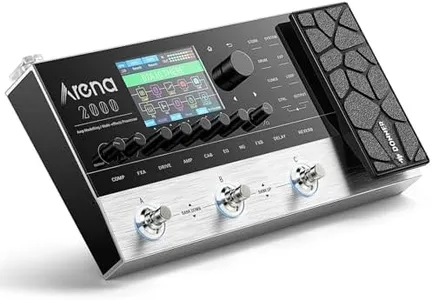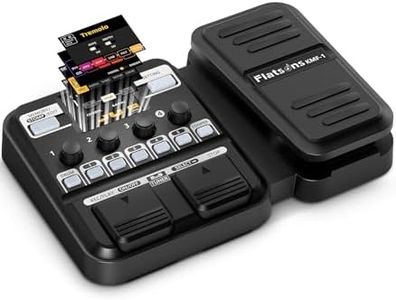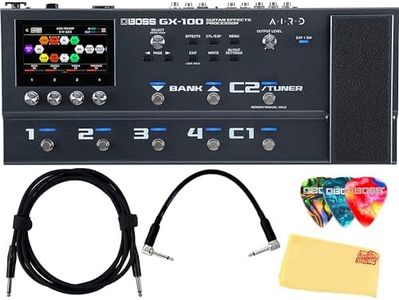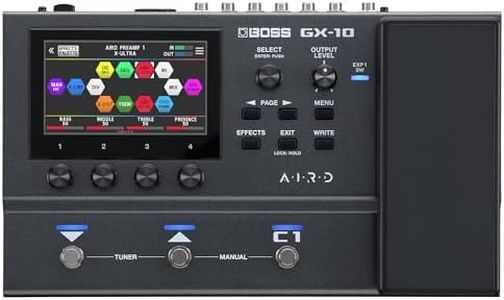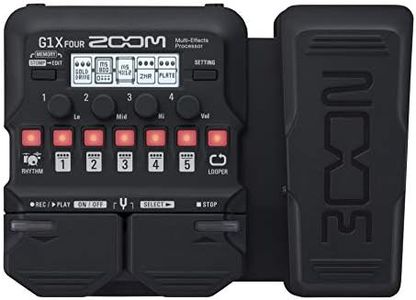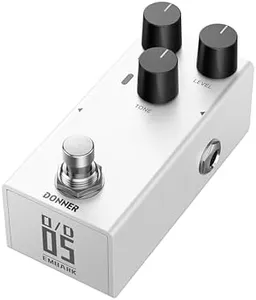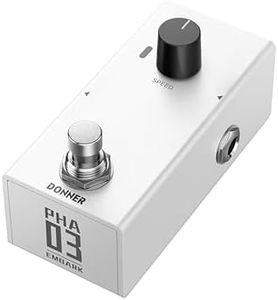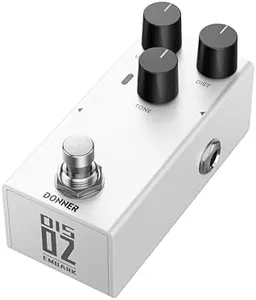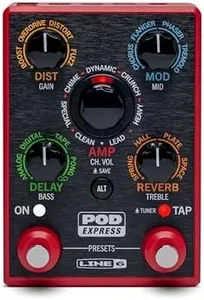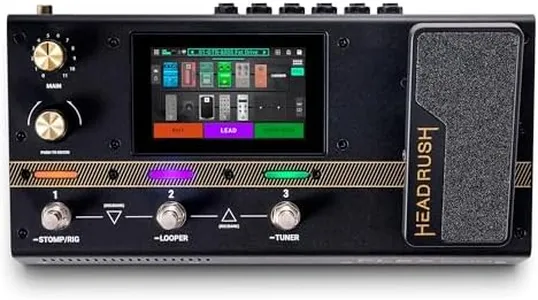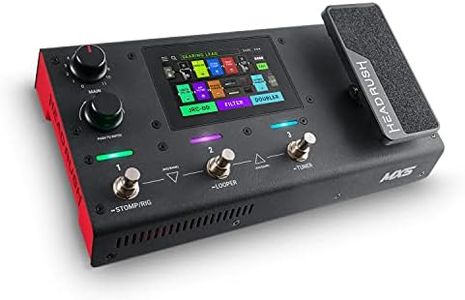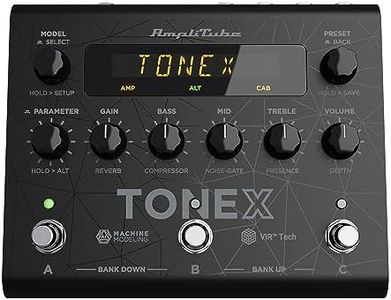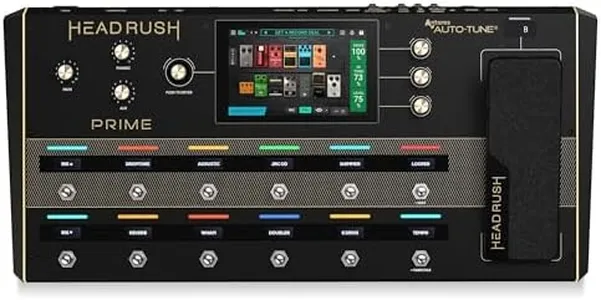10 Best Multi Effects Pedals 2025 in the United States
Our technology thoroughly searches through the online shopping world, reviewing hundreds of sites. We then process and analyze this information, updating in real-time to bring you the latest top-rated products. This way, you always get the best and most current options available.

Our Top Picks
Winner
Donner Arena 2000 Guitar Multi-Effects Pedal with 278 Effects, 100 IRs, Looper, Drum Machine, Amp Modeling, XLR and MIDI Support
Most important from
418 reviews
The Donner Arena 2000 Guitar Multi-Effects Pedal is a robust choice for musicians looking for versatility and sound quality. With 278 effects, including 100 classic simulations and 80 amp models, it caters to a wide range of musical styles, from pop to metal. The rich sound quality is enhanced by FAVCM technology and 24-bit audio processing, which helps eliminate the overly digital sound common in many effects pedals, making it suitable for both practice and live performances.
One of the standout features is its extensive connectivity options, including XLR and MIDI support, which allows for seamless integration into various setups. The inclusion of 40 drum rhythms and a 60-second looper is particularly useful for solo artists looking to create full arrangements on their own. Plus, the headphone output makes it easy to practice quietly at home.
The Arena 2000 does have some drawbacks. While it offers a lot of effects, the lack of a battery compartment means you need to use it with a power source, which might limit portability for some users. Additionally, it’s advisable to use headphones with a specific impedance range, as others may lead to low volume, which could be frustrating during practice. In terms of build quality, the pedal is solid and designed to withstand the rigors of both home and stage use. The user interface is fairly intuitive, but beginners may still need some time to familiarize themselves with all the functions and settings. The ability to edit tones via a computer or mobile device adds a modern touch, appealing to tech-savvy musicians.
The Donner Arena 2000 is an excellent multi-effects pedal for guitarists who value sound quality and versatility, though it may not be the ideal choice for those who need a highly portable solution or are entirely new to multi-effects setups.
Most important from
418 reviews
Flatsons KMF-1 Multi Effects Guitar Pedal, 18 Amp/Cab Electric Guitar Effects Processor with 77 Effects, 42 Drum Rhythms, Aux In, Looper Wah Reverb Tuner Distortion Pedal for Indoor Outdoor
Most important from
28 reviews
The Flatsons KMF-1 Multi Effects Guitar Pedal offers a comprehensive range of features for both novice and professional musicians. With 77 effects, 18 amp models, and 18 cabinet simulators, it provides extensive options for sound customization. The advanced DSP technology with TSAC and 512-point IR Sampling ensures high-quality sound, making it suitable for studio recordings and live performances.
The pedal includes 50 preset patches, 42 drum rhythms, and a 30-second built-in looper to enhance music creation. The user interface is intuitive, featuring a vibrant 128×32 LCD and easy-to-use knobs and buttons. Connectivity options are robust, with AUX and USB ports, allowing seamless integration with other devices. The build quality is solid, designed to withstand indoor and outdoor use, and the option to use 6 AA batteries provides flexibility for portable use. However, the battery life is limited to 2.5 hours, which might not be sufficient for longer outdoor sessions.
Additionally, the product includes a 12-month guarantee and 24/7 customer service, ensuring reliability and support. While the extensive feature set is impressive, beginners might find the numerous options overwhelming. The product's weight and dimensions are manageable, making it relatively easy to transport. Given its versatility and sound quality, the Flatsons KMF-1 is well-suited for musicians who demand a wide array of effects and reliable performance both in studio and live settings.
Most important from
28 reviews
Boss GX-100 Guitar Multi-effects Pedal Bundle with Instrument Cable, Patch Cable, Picks, and Austin Bazaar Polishing Cloth
Most important from
81 reviews
The Boss GX-100 Guitar Multi-effects Pedal Bundle offers a comprehensive solution for guitar and bass players seeking versatility and high-quality sound in their performances. One of its standout features is the AIRD technology, which provides a natural tube amp feel and allows for precise sound tailoring for different setups. With over 150 built-in effects from the renowned BOSS library, musicians have a wide range of sounds at their disposal, including classic overdrives, distortions, and unique modulations, delays, and reverbs, making it suitable for nearly any musical style or genre.
The pedal boasts an impressive 100 preset memories, allowing users to save and recall customized sounds effortlessly. The color touch display enhances user experience by offering intuitive control over patch selection, effect adjustments, and signal chain configurations. Additionally, the GX-100's build quality is robust, ensuring durability for both studio and live performances. Connectivity is well-supported with USB capabilities and send/return jacks to integrate external stompboxes or effects loops. However, the corded electric power supply might limit mobility for some users who prefer battery-operated units.
The bundle includes practical accessories like instrument and patch cables, picks, and a polishing cloth, adding extra value. It might be overwhelming for beginners due to the plethora of features and the learning curve associated with mastering them, but the GX-100 is a solid choice for intermediate to advanced players looking for a versatile and high-quality multi-effects pedal.
Most important from
81 reviews
Buying Guide for the Best Multi Effects Pedals
When it comes to choosing a multi-effects pedal, it's important to consider your specific needs as a musician. Multi-effects pedals are versatile tools that can provide a wide range of sounds and effects, making them a great addition to any guitarist's setup. To find the best fit for you, you'll need to look at several key specifications and understand how they align with your playing style and requirements.FAQ
Most Popular Categories Right Now
